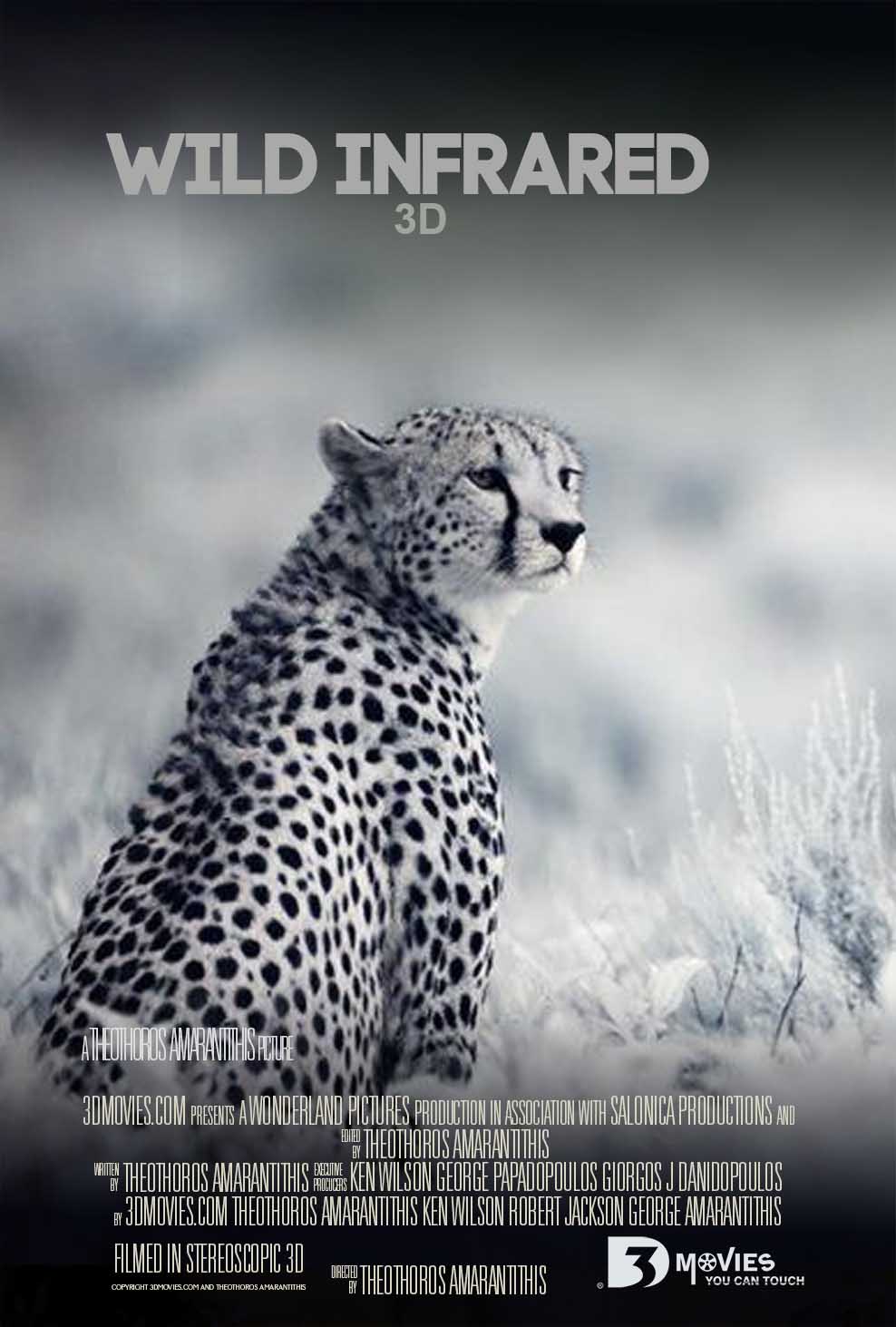3D Movies You Can Touch!®
Infrared Galleries Copyright 3dmovies.com

WILD INFRARED – 3D – movie poster
Changing the world one movie at a time!™
Infrared
Infrared (IR) is invisible radiant energy, electromagnetic radiation with longer wavelengths than those of visible light, extending from the nominal red edge of the visible spectrum at 700 nanometers (frequency 430 THz) to 1 mm (300 GHz) (although people can see infrared up to at least 1050 nm in experiments). Most of the thermal radiation emitted by objects near room temperature is infrared.Infrared radiation was discovered in 1800 by astronomer Sir William Herschel, who discovered a type of invisible radiation in the spectrum lower in energy than red light, by means of its effect upon a thermometer.
Slightly more than half of the total energy from the Sun was eventually found to arrive on Earth in the form of infrared. The balance between absorbed and emitted infrared radiation has a critical effect on Earth’s climate.Infrared energy is emitted or absorbed by molecules when they change their rotational-vibrational movements. Infrared energy excites vibrational modes in a molecule through a change in the dipole moment, making it a useful frequency range for study of these energy states for molecules of the proper symmetry. Infrared spectroscopy examines absorption and transmission of photons in the infrared energy range.[7]Infrared radiation is used in industrial, scientific, and medical applications. Night-vision devices using active near-infrared illumination allow people or animals to be observed without the observer being detected. Infrared astronomy uses sensor-equipped telescopes to penetrate dusty regions of space, such as molecular clouds; detect objects such as planets, and to view highly red-shifted objects from the early days of the universe. Infrared thermal-imaging cameras are used to detect heat loss in insulated systems, to observe changing blood flow in the skin, and to detect overheating of electrical apparatus.Thermal-infrared imaging is used extensively for military and civilian purposes. Military applications include target acquisition, surveillance, night vision, homing and tracking. Humans at normal body temperature radiate chiefly at wavelengths around 10 μm (micrometers). Non-military uses include thermal efficiency analysis, environmental monitoring, industrial facility inspections, remote temperature sensing, short-ranged wireless communication, spectroscopy, and weather forecasting.
Definition and relationship to the electromagnetic spectrum
Infrared radiation extends from the nominal red edge of the visible spectrum at 700 nanometers (nm) to 1 mm. This range of wavelengths corresponds to a frequency range of approximately 430 THz down to 300 GHz. Below infrared is the microwave portion of the electromagnetic spectrum.

| Light comparison | |||||||
| Name | Wavelength | Frequency (Hz) | Photon Energy (eV) | ||||
|---|---|---|---|---|---|---|---|
| Gamma ray | less than 0.01 nm | more than 30 EHz | 124 keV – 300+ GeV | ||||
| X-ray | 0.01 nm – 10 nm | 30 EHz – 30 PHz | 124 eV – 124 keV | ||||
| Ultraviolet | 10 nm – 380 nm | 30 PHz – 790 THz | 3.3 eV – 124 eV | ||||
| Visible | 380 nm–700 nm | 790 THz – 430 THz | 1.7 eV – 3.3 eV | ||||
| Infrared | 700 nm – 1 mm | 430 THz – 300 GHz | 1.24 meV – 1.7 eV | ||||
| Microwave | 1 mm – 1 meter | 300 GHz – 300 MHz | 1.7 eV – 1.24 meV | ||||
| Radio | 1 mm – 100,000 km | 300 GHz – 3 Hz | 12.4 feV – 1.24 meV | ||||
Natural infrared
Sunlight, at an effective temperature of 5,780 kelvins, is composed of nearly thermal-spectrum radiation that is slightly more than half infrared. At zenith, sunlight provides an irradiance of just over 1 kilowatt per square meter at sea level. Of this energy, 527 watts is infrared radiation, 445 watts is visible light, and 32 watts is ultraviolet radiation.[10]
On the surface of Earth, at far lower temperatures than the surface of the Sun, almost all thermal radiation consists of infrared in various wavelengths. Of these natural thermal radiation processes only lightning and natural fires are hot enough to produce much visible energy, and fires produce far more infrared than visible-light energy.
3D movies from 3D Movies You Can Touch!
A collection of “3D Movies You Can Touch!” ®. All Rights Reserved. Copyright © The 3D Film Company and Ted Amaradidis.
3D Movies You Can Touch!®
Changing the world one movie at a time!™








